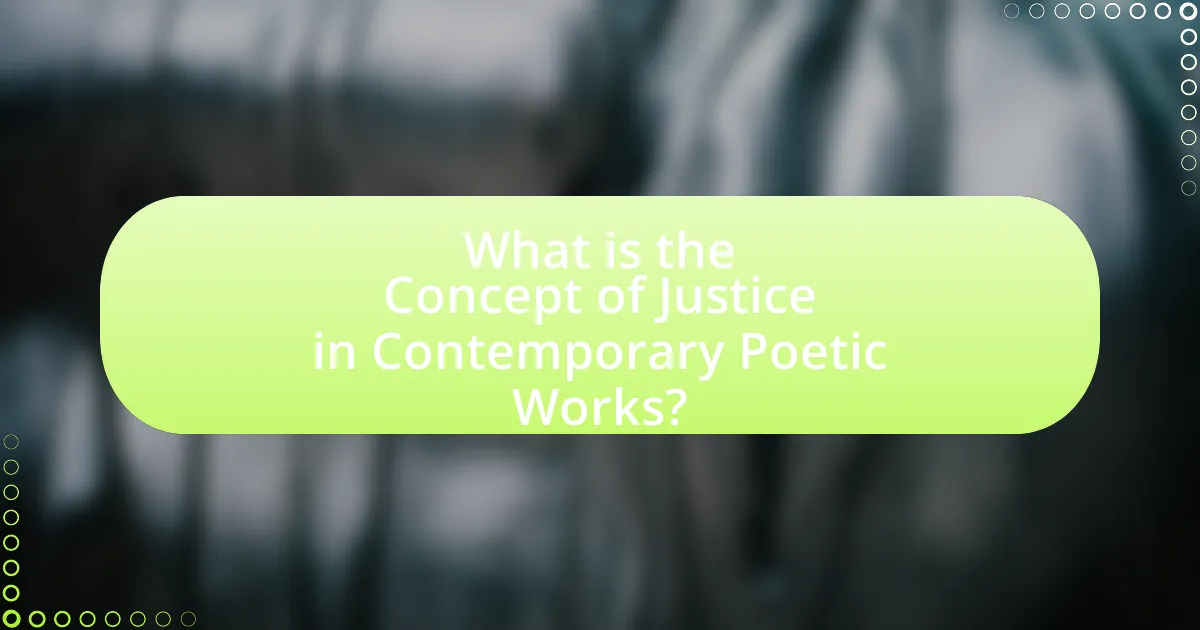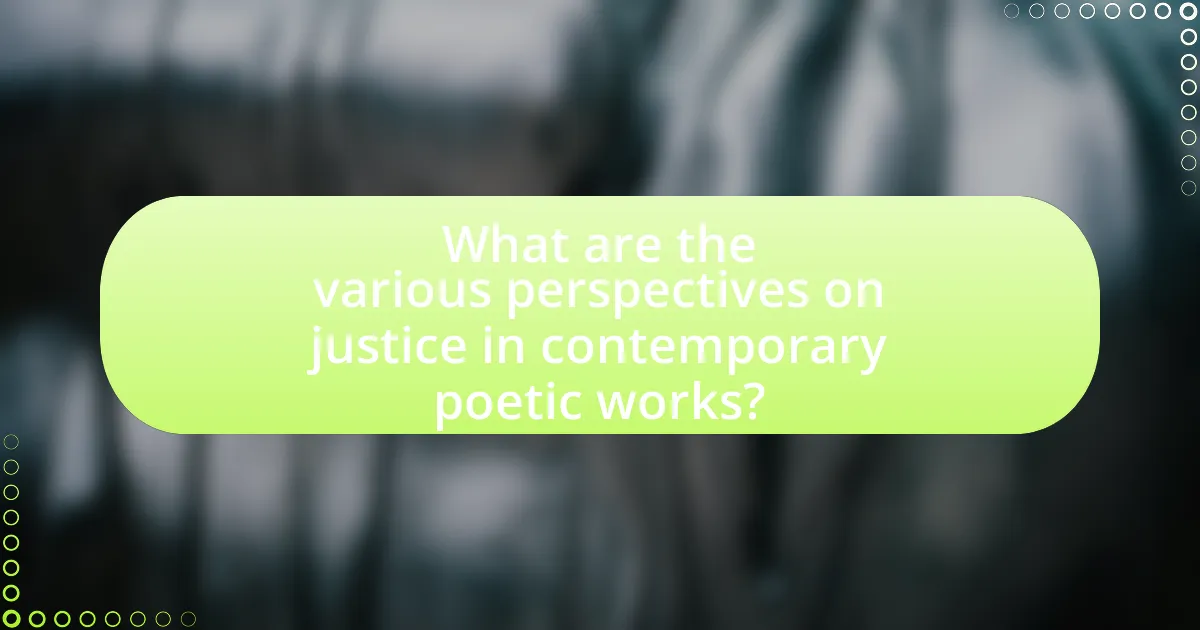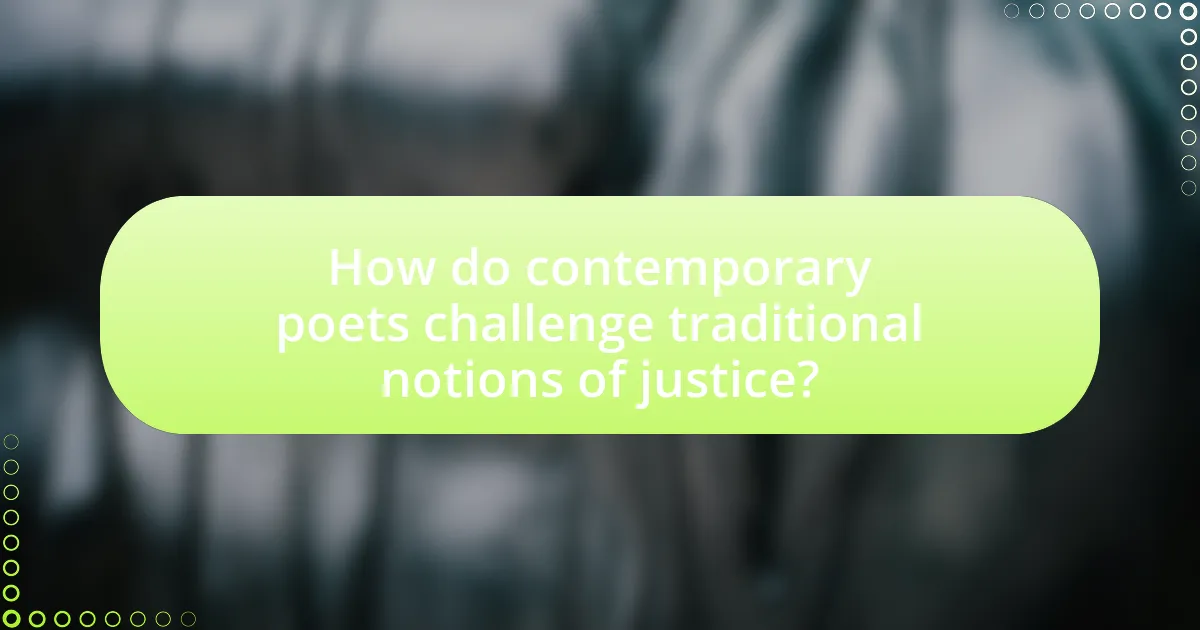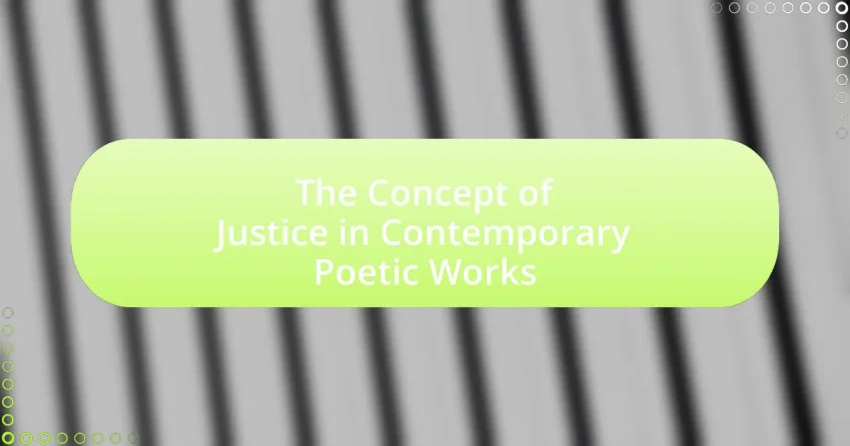The concept of justice in contemporary poetic works encompasses themes of social equity, personal accountability, and systemic injustice. Poets such as Claudia Rankine and Ocean Vuong utilize their craft to address issues like racial inequality, gender discrimination, and environmental degradation, serving as a medium for social critique and advocacy. The article explores how justice is defined in poetry, the historical influences shaping its interpretation, and the various perspectives poets adopt, highlighting the significance of personal experience, cultural backgrounds, and activism in shaping their views on justice. Additionally, it examines the poetic devices used to convey justice and the impact of form and structure on its portrayal, ultimately illustrating how contemporary poetry challenges traditional notions of justice and inspires action for social change.

What is the Concept of Justice in Contemporary Poetic Works?
The concept of justice in contemporary poetic works often explores themes of social equity, personal accountability, and systemic injustice. Poets utilize their craft to reflect on societal issues such as racial inequality, gender discrimination, and environmental degradation, aiming to provoke thought and inspire change. For instance, works by poets like Claudia Rankine and Ocean Vuong address the complexities of identity and the impact of societal structures on individual experiences, illustrating how poetry can serve as a medium for social critique and advocacy. This engagement with justice not only highlights the struggles faced by marginalized communities but also emphasizes the role of art in fostering empathy and understanding within society.
How is justice defined in contemporary poetry?
Justice in contemporary poetry is often defined as a multifaceted exploration of social, political, and personal equity, reflecting the complexities of modern societal issues. Poets utilize their work to address themes such as systemic injustice, inequality, and the quest for personal and collective rights, often drawing from real-world events and movements. For instance, poets like Claudia Rankine in “Citizen” examine racial injustice and the lived experiences of marginalized communities, illustrating how poetry serves as a medium for activism and awareness. This alignment of poetic expression with social justice movements underscores the role of contemporary poetry in advocating for change and highlighting the ongoing struggles for fairness and representation.
What are the historical influences on the concept of justice in poetry?
The historical influences on the concept of justice in poetry stem from various philosophical, cultural, and literary traditions. Ancient Greek philosophy, particularly the works of Plato and Aristotle, emphasized the idea of justice as a virtue and a societal ideal, which significantly shaped poetic expressions in Western literature. Additionally, the influence of religious texts, such as the Bible and the Quran, introduced moral dimensions to justice, often depicted in poetic forms like psalms and verses. The Enlightenment period further contributed to the discourse on justice, with poets like John Milton and William Blake exploring themes of individual rights and social justice. These historical contexts have led to a rich tapestry of poetic interpretations of justice, reflecting societal values and ethical dilemmas throughout the ages.
How do different poets interpret justice in their works?
Different poets interpret justice through various lenses, reflecting societal issues, personal experiences, and philosophical inquiries. For instance, Langston Hughes often portrays justice as a struggle against racial inequality, emphasizing the need for social change in works like “Let America Be America Again.” In contrast, Emily Dickinson explores justice in a more introspective manner, questioning moral absolutes and the nature of fairness in her poems. Additionally, contemporary poets like Claudia Rankine address systemic injustices, particularly in relation to race and identity, as seen in her collection “Citizen: An American Lyric.” These interpretations highlight the multifaceted nature of justice, revealing how poets use their art to critique, question, and redefine the concept within their cultural contexts.
Why is the concept of justice significant in contemporary poetry?
The concept of justice is significant in contemporary poetry because it serves as a lens through which poets explore social issues, personal experiences, and collective struggles. Contemporary poets often address themes of inequality, oppression, and human rights, reflecting the urgent need for justice in society. For instance, poets like Claudia Rankine in “Citizen: An American Lyric” examine racial injustice and its impact on identity, illustrating how poetry can articulate the complexities of social justice. This focus on justice not only resonates with readers but also fosters dialogue about pressing societal concerns, making it a vital element in contemporary poetic discourse.
What themes related to justice are prevalent in modern poetic works?
Modern poetic works frequently explore themes of social justice, systemic inequality, and personal accountability. These themes reflect the ongoing struggles against oppression and the quest for equity in society. For instance, poets like Claudia Rankine and Ocean Vuong address racial injustice and the impact of identity on personal experience, highlighting the emotional and societal ramifications of discrimination. Additionally, the theme of restorative justice is evident in works that advocate for healing and reconciliation rather than punishment, emphasizing the importance of community and understanding in addressing wrongs. Such thematic explorations are supported by the increasing prevalence of poetry in social movements, where verse serves as a powerful tool for activism and awareness.
How does the exploration of justice reflect societal issues in poetry?
The exploration of justice in poetry serves as a mirror to societal issues, highlighting themes such as inequality, oppression, and the quest for human rights. Poets often address injustices faced by marginalized communities, using their work to raise awareness and provoke thought. For instance, the poetry of Langston Hughes during the Harlem Renaissance reflects the racial injustices of his time, illustrating how systemic racism affects individuals and communities. Similarly, contemporary poets like Claudia Rankine confront issues of police brutality and social injustice, as seen in her collection “Citizen,” which blends poetry with critical commentary on race relations in America. These examples demonstrate how poetry not only captures the essence of societal struggles but also acts as a catalyst for social change by engaging readers in critical conversations about justice.

What are the various perspectives on justice in contemporary poetic works?
Contemporary poetic works present various perspectives on justice, often reflecting societal issues, personal experiences, and cultural contexts. Poets like Claudia Rankine explore racial injustice and systemic inequality, as seen in her collection “Citizen,” which addresses microaggressions and the lived experiences of Black individuals in America. Similarly, Ocean Vuong’s “Night Sky with Exit Wounds” delves into themes of familial trauma and the search for identity, highlighting the intersection of personal and collective justice. Additionally, poets such as Amanda Gorman use their platforms to advocate for social justice, as demonstrated in her inaugural poem “The Hill We Climb,” which emphasizes unity and resilience in the face of injustice. These works collectively illustrate how contemporary poetry serves as a medium for examining and challenging notions of justice across different dimensions.
How do cultural backgrounds influence poetic expressions of justice?
Cultural backgrounds significantly influence poetic expressions of justice by shaping the themes, language, and perspectives that poets employ. For instance, poets from marginalized communities often reflect their unique experiences of injustice, using specific cultural references and vernacular that resonate with their audience. This is evident in the works of poets like Audre Lorde and Langston Hughes, who address racial and social injustices through the lens of their cultural identities. Their poetry often incorporates historical context, such as the civil rights movement, which informs their expressions of justice and highlights the systemic inequalities faced by their communities. Thus, cultural backgrounds provide a framework through which poets articulate their understanding of justice, making their work both personal and universally relevant.
What role does personal experience play in shaping a poet’s view of justice?
Personal experience significantly influences a poet’s view of justice by providing a unique lens through which they interpret societal issues. Poets often draw from their own life experiences, including trauma, injustice, or cultural background, which shapes their understanding of fairness and equity. For instance, poets like Maya Angelou and Langston Hughes have used their personal narratives of racial discrimination and social inequality to articulate broader themes of justice in their work. This connection between personal experience and poetic expression allows for a more authentic and relatable exploration of justice, as it reflects the complexities of real-life struggles and triumphs.
How do gender and identity intersect with the concept of justice in poetry?
Gender and identity significantly intersect with the concept of justice in poetry by shaping the themes, perspectives, and narratives presented in poetic works. Poets often explore how societal norms related to gender and identity influence experiences of injustice, highlighting issues such as discrimination, inequality, and marginalization. For instance, contemporary poets like Claudia Rankine and Ocean Vuong address racial and gender identities to critique systemic injustices, illustrating how personal experiences of identity inform broader societal critiques. This intersection is evident in Rankine’s “Citizen,” which examines the microaggressions faced by Black individuals, thereby linking personal identity to collective justice struggles. Such works demonstrate that poetry serves as a powerful medium for articulating the complexities of justice as they relate to gender and identity, making these intersections crucial for understanding contemporary poetic discourse.
What poetic devices are commonly used to convey justice?
Common poetic devices used to convey justice include imagery, symbolism, and alliteration. Imagery creates vivid mental pictures that evoke emotions related to justice, allowing readers to visualize the consequences of injustice or the triumph of fairness. Symbolism often represents justice through objects or characters, such as scales or a blindfolded figure, which embody the principles of fairness and impartiality. Alliteration enhances the rhythm and emphasis of key phrases, making the message of justice more memorable and impactful. These devices collectively reinforce the thematic exploration of justice in contemporary poetry, illustrating its complexities and societal implications.
How do metaphors and imagery enhance the theme of justice in poetry?
Metaphors and imagery enhance the theme of justice in poetry by creating vivid representations that evoke emotional responses and deepen understanding. For instance, metaphors can transform abstract concepts of justice into relatable images, such as comparing justice to a scale, which illustrates balance and fairness. Imagery further enriches this theme by painting detailed scenes that allow readers to visualize the consequences of injustice, such as depicting a broken community or a solitary figure seeking retribution. This use of figurative language not only engages the reader’s senses but also encourages reflection on moral dilemmas, making the theme of justice more impactful and resonant.
What is the impact of form and structure on the portrayal of justice?
The impact of form and structure on the portrayal of justice is significant, as it shapes how themes of justice are communicated and perceived. In contemporary poetic works, the use of specific forms—such as sonnets, free verse, or narrative structures—can influence the emotional resonance and clarity of justice-related themes. For instance, a tightly structured sonnet may convey a sense of order and resolution, reflecting traditional views of justice, while free verse can express chaos and complexity, aligning with modern interpretations of justice as multifaceted and subjective. This relationship is evident in works like Claudia Rankine’s “Citizen,” where fragmented structure mirrors the disjointed experience of racial injustice, emphasizing the urgency and fragmentation of contemporary social issues. Thus, the chosen form and structure not only enhance the thematic depth but also guide the reader’s understanding and emotional response to justice.

How do contemporary poets challenge traditional notions of justice?
Contemporary poets challenge traditional notions of justice by employing innovative language, diverse perspectives, and personal narratives that question established legal and moral frameworks. For instance, poets like Claudia Rankine in “Citizen: An American Lyric” confront systemic racism and social injustice, illustrating how personal experiences intersect with broader societal issues. This approach not only highlights the inadequacies of conventional justice systems but also emphasizes the emotional and psychological impacts of injustice on individuals and communities. By blending personal and political themes, contemporary poetry serves as a powerful medium for critiquing and redefining justice in a way that resonates with modern audiences.
What innovative approaches do poets take to redefine justice?
Poets redefine justice through innovative approaches such as employing personal narratives, utilizing metaphorical language, and engaging with social issues. Personal narratives allow poets to express individual experiences of injustice, making abstract concepts tangible and relatable. For instance, Claudia Rankine’s “Citizen” explores racial microaggressions, illustrating systemic racism through personal anecdotes. Metaphorical language enables poets to convey complex ideas about justice in a nuanced manner; for example, Audre Lorde’s use of the “erotic” in her work emphasizes the connection between personal empowerment and social justice. Additionally, poets often engage with contemporary social issues, using their platforms to advocate for marginalized voices, as seen in the works of Amanda Gorman, whose poem “The Hill We Climb” addresses themes of unity and resilience in the face of injustice. These approaches collectively challenge traditional notions of justice and invite readers to reconsider their understanding of equity and fairness.
How do contemporary works critique existing legal and social systems?
Contemporary works critique existing legal and social systems by exposing systemic injustices and highlighting the failures of these systems to protect marginalized communities. For instance, poets like Claudia Rankine in “Citizen: An American Lyric” illustrate the pervasive nature of racism and the inadequacies of the legal system in addressing racial violence, thereby prompting readers to question the effectiveness of current laws. Additionally, works such as “The New Jim Crow” by Michelle Alexander argue that mass incarceration functions as a modern racial caste system, critiquing the legal frameworks that perpetuate inequality. These critiques are grounded in real-world examples and statistics, such as the disproportionate incarceration rates of Black Americans, which serve to validate the arguments presented in these contemporary works.
What role does activism play in the poetry of justice?
Activism serves as a catalyst in the poetry of justice by amplifying marginalized voices and addressing social injustices. Poets often use their work to challenge systemic oppression, raise awareness about human rights issues, and inspire collective action. For instance, the poetry of writers like Audre Lorde and Langston Hughes reflects their activism, as they confront racism, sexism, and inequality through powerful imagery and language. This connection between activism and poetry not only fosters empathy but also mobilizes readers towards social change, demonstrating the profound impact of poetic expression in the pursuit of justice.
How can readers engage with the concept of justice in poetry?
Readers can engage with the concept of justice in poetry by analyzing the themes, language, and emotional resonance within the poems. This engagement allows readers to reflect on societal issues, personal experiences, and moral dilemmas presented in the work. For instance, contemporary poets like Claudia Rankine in “Citizen: An American Lyric” address racial injustice, prompting readers to confront uncomfortable truths about systemic inequality. By interpreting the imagery and metaphors used, readers can gain insights into the complexities of justice and its implications in real-world contexts. This analytical approach fosters a deeper understanding of how poetry can serve as a vehicle for social commentary and personal reflection on justice.
What are effective ways to analyze poetic works focused on justice?
Effective ways to analyze poetic works focused on justice include examining thematic elements, structural components, and historical context. Thematic analysis involves identifying key motifs related to justice, such as oppression, equality, and resistance, which can reveal the poet’s stance on social issues. Structural analysis looks at the form, meter, and rhyme schemes, as these can enhance or undermine the poem’s message about justice. Historical context provides insight into the societal conditions that influenced the poet’s work, allowing for a deeper understanding of the justice themes presented. For instance, analyzing Maya Angelou’s “Still I Rise” reveals themes of resilience against oppression, supported by her personal experiences and the civil rights movement, illustrating how context shapes poetic expression on justice.
How can poetry inspire action and change regarding justice issues?
Poetry can inspire action and change regarding justice issues by evoking emotional responses and raising awareness about social injustices. Through vivid imagery and powerful language, poets can articulate the struggles faced by marginalized communities, making complex issues relatable and urgent. For instance, the works of poets like Maya Angelou and Langston Hughes have historically galvanized movements for civil rights by highlighting systemic oppression and calling for equality. Their poems not only reflect societal issues but also serve as rallying cries, motivating individuals to engage in activism and advocacy. This connection between poetry and social change is evidenced by the impact of spoken word performances at protests, where poetry becomes a tool for mobilization and solidarity.
